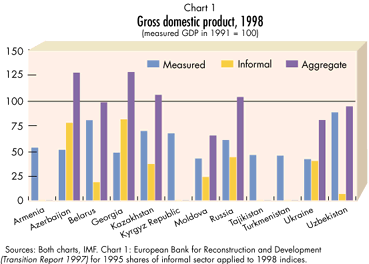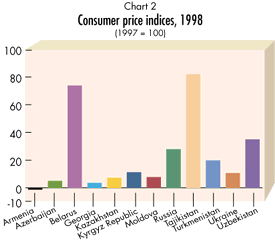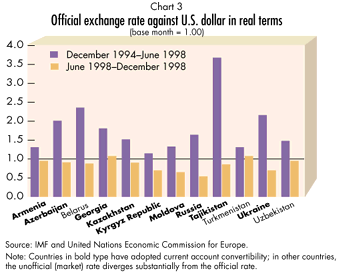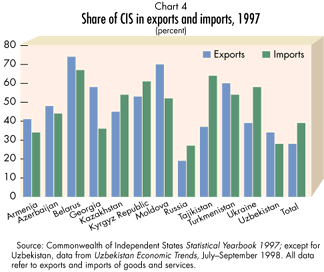|

Escape Routes from Post-Soviet Inflation and Recession
Michael Kaser
The 12 CIS countries inherited from the Soviet system strong inflationary pressures
and distorted prices. By 1998, most had greatly moderated inflation. In the wake of the
Russian crisis, how can they now secure economic growth without prejudicing the gains that
have been made?
When in 1924 the Soviet government exchanged 50 billion "old" rubles for 1
"new" ruble in a currency reform, ceased monetizing the budget deficit, and made
the ruble convertible, Lenin's New Economic Policy began to enjoy monetary stability.
Severe inflation returned, however, when ruble convertibility was abrogated and the
five-year plans began in 1928. Inflation was at first open, and, as rapidly rising
consumer prices overtook state-fixed wages, household real incomes were cut to make
resources available for investment and defense. Inflation was soon "repressed"
by state dictation of prices, which was evident in persistent shortages and an overhang
(surplus) of households' unspent money.
The demands of investment, the military, the bureaucracy, and education, health, and
social welfare greatly exceeded the supply of labor and natural resources, which were, in
any event, used inefficiently. The Soviet Union was transformed, through forced
collectivization, from being a food exporter to being unable to feed itself. The command
economy limited the competitive gains that could be made from international trade. Within
the former Soviet Union, price relativities bore little or no relation to the balance
between the supply of and the demand for goods or services.
An operational price mechanism is essential to a market system, and the governments of
the successor states to the Soviet Union accepted an immediate price liberalization,
designed to switch inflation from "repressed" to "open," eliminate the
money overhang, and allow foreign prices to correct domestic relativities. The Baltic
countries went straight for sound and stable currencies, backed by a continuing tight
monetary policy. Benefiting from a shorter experience under the command economy, as well
as a thoroughgoing switch to a market system and democratic government, these countries
were rewarded by proportionately more foreign support.
The remaining 12 countries that were to participate in the Commonwealth of Independent
States (CIS) continued to use the Soviet ruble, and had to follow Russia's lead in January
1992 in decontrolling most retail and wholesale prices. They could not have anticipated
the extent, or the persistence, of the ensuing price rise: in Russia, consumer prices rose
16-fold and producer prices rose 20-fold in 1992 alone. The following year, consumer
prices in the CIS increased by 875 percent in Russia, 4,085 percent in Georgia, and 4,735
percent in Ukraine. Inflation spread through each of the 12 states and slackened only
after the establishment of separate currencies.
"Informal" production dangers
 Separated into 12 economies between which many previous
transaction ties were ruptured, activities operating within legal parameters slumped. The
decline was exacerbated in some countries by war or civil conflict. By 1998, production
for the group, as reflected in conventionally measured GDP, was less than two-thirds of
its late-Soviet level. Other economic activities were deflected into the informal sector,
which so expanded in five of the eight CIS states for which estimates have been made
(Chart 1) that they brought the aggregate of the two sectors in 1998 to the level of
measured ("formal") GDP in 1991. Both formal and informal sectors supply goods
and services that conform more closely to household and enterprise demand than those
produced under Soviet planning. One can therefore say that more "welfare" is now
being generated per ruble produced than under the command economy. But even if informal
output has made up the deficiency resulting from the fall in measured GDP, notional
welfare may still be lower in aggregate because income and wealth disparities have
increased, while the provision of social services has diminished. Separated into 12 economies between which many previous
transaction ties were ruptured, activities operating within legal parameters slumped. The
decline was exacerbated in some countries by war or civil conflict. By 1998, production
for the group, as reflected in conventionally measured GDP, was less than two-thirds of
its late-Soviet level. Other economic activities were deflected into the informal sector,
which so expanded in five of the eight CIS states for which estimates have been made
(Chart 1) that they brought the aggregate of the two sectors in 1998 to the level of
measured ("formal") GDP in 1991. Both formal and informal sectors supply goods
and services that conform more closely to household and enterprise demand than those
produced under Soviet planning. One can therefore say that more "welfare" is now
being generated per ruble produced than under the command economy. But even if informal
output has made up the deficiency resulting from the fall in measured GDP, notional
welfare may still be lower in aggregate because income and wealth disparities have
increased, while the provision of social services has diminished.
Although the informal economy moderates poverty at the bottom of the income scale, it
widens inequality when rich rewards, often resulting from tax evasion or more serious
crimes, are reaped at the top. Tax evasion is the reason for the informal economy's
prevalence in developed market economies (accounting for some one-tenth of aggregate
production in the European Union). Because of its lack of transparency, the informal
sector is more corrupt, invests less than the formal sector, and can employ inefficient
modes of production. For example, urban workers must often till small plots for vegetables
or make tedious journeys into the countryside to buy produce.
Diagnosis: "slumpflation"
Prior to the Soviet transition to a market economy, there had been several notable
conquests of severe inflation elsewhere—for example, in 1985–86 in Bolivia, a
developing economy, and in Israel, a developed one. Developed countries had experienced
deflation and depression (as in the 1930s) as well as "stagflation" (inflation
without growth), but "slumpflation" (high inflation and seriously negative
growth) was unprecedented. In post-Soviet conditions, escape from either of the twin
phenomena prejudices escape from the other. As Joseph Stiglitz, Chief Economist at the
World Bank, put it (Stiglitz, 1998): "The single-market focus on inflation may not
only distort economic policies—preventing the economy from living up to its full
growth and output potentials—but also lead to institutional arrangements that reduce
economic flexibility without gaining important growth benefits." Six CIS
governments—Armenia, Georgia, Kazakhstan, the Kyrgyz Republic, Moldova, and
Russia—gave priority to low inflation and a stable exchange rate. Low inflation and
stable exchange rates would underwrite the market relationships essential within a
privatizing and open economy, and foster both domestic investment and foreign capital
inflows. This, in turn, would expand exports and equilibrate the external balance.
But inadequate investment materialized. First, much capital capacity had gone out of
use, obsolescent assets were not replaced, and new technologies were not introduced. For
the entire CIS, the measured production that has been "lost" since independence
amounts to more than twice the volume of output in 1991. Belarus, the Kyrgyz Republic,
Russia, Ukraine, and Uzbekistan were particularly hard hit by the reduction in military
demand, as the "defense dividend" did not lead to any increase in nondefense
spending. Second, at lower outputs and with recession expected to continue, enterprises
undertook little investment. According to the United Nations Economic Commission for
Europe, the three largest CIS states (Russia, Ukraine, and Kazakhstan, which together
generated 83 percent of CIS GDP) in 1997, invested less than one-fifth of the investment
they had made in 1990. The fall would appear less steep if military investment and
unfinished construction were excluded from the Soviet baseline.
 All CIS states except Belarus, Tajikistan, and Uzbekistan
achieved low inflation by the end of 1997 (Chart 2), but the cost was constraints on the
current and capital expenditure that could have replaced at least some of the lost demand.
Of the limited resources held by the state, some were misused—corruptly or in
unrequitable subsidies—and too little went to Keynesian demand stimuli, such as
public works and social transfers. The process of government revenue-raising and
expenditure helped to channel enterprise and household transactions away from the formal
(and hence taxable) sector into the informal. In a succeeding period, lower tax receipts
(as a proportion of aggregate economic activity) further reduced expenditure on the formal
sector. In a vicious "double helix," the formal economy declined or stagnated
while the informal sector spiraled upward. The social effects were serious. The proportion
of Russians living in "extreme poverty" (those with incomes of less than half
the subsistence minimum) rose, according to the World Bank, from 11 percent in 1994 to 15
percent in 1997 and is projected at 18.5 percent next year. In Ukraine, real wages last
year were one-third of their 1990 level. All CIS states except Belarus, Tajikistan, and Uzbekistan
achieved low inflation by the end of 1997 (Chart 2), but the cost was constraints on the
current and capital expenditure that could have replaced at least some of the lost demand.
Of the limited resources held by the state, some were misused—corruptly or in
unrequitable subsidies—and too little went to Keynesian demand stimuli, such as
public works and social transfers. The process of government revenue-raising and
expenditure helped to channel enterprise and household transactions away from the formal
(and hence taxable) sector into the informal. In a succeeding period, lower tax receipts
(as a proportion of aggregate economic activity) further reduced expenditure on the formal
sector. In a vicious "double helix," the formal economy declined or stagnated
while the informal sector spiraled upward. The social effects were serious. The proportion
of Russians living in "extreme poverty" (those with incomes of less than half
the subsistence minimum) rose, according to the World Bank, from 11 percent in 1994 to 15
percent in 1997 and is projected at 18.5 percent next year. In Ukraine, real wages last
year were one-third of their 1990 level.
Throughout the CIS, social infrastructure and services could scarcely be further
reduced. Some governments allowed arrears to accumulate on their spending commitments. In
the short run, outlays were spuriously lowered, but the obligations remained. The
nonpayment of civil and social service salaries and of pensions and allowances exacerbated
poverty and further reduced household demand. Social services that had previously been
channeled through state enterprises were curtailed by privatization or were put on a
fee-for-service basis. This moderated central government payments, but households either
stopped using such services or further cut their spending on alternative goods and
services.
Borrowing to slim budget deficits
By 1995–96, most CIS states were precluded under the terms of their IMF-supported
programs from creating money to close their budget deficits and governments had either to
reduce the deficit or to borrow to cover it. Tax revenue was much reduced as a share of a
shrunken (measured) GDP: IMF data show a fall from 43 percent of GDP in the six final
years of the Soviet Union to 31 percent in the CIS as a whole in 1997. In Russia, the
central government's position was still weaker. By 1997, according to European Bank for
Reconstruction and Development (EBRD) data, the federal budget received only 28 percent of
government revenue; the rest went to off-budget agencies or to regional and local
authorities, which wasted about half their income on subsidies. By contrast, the 1999
budget for Ukraine retains 69 percent of revenue centrally.
Much of the tax base was illusory. By mid-1998, nearly two-thirds of Russian
enterprises were incurring losses, and industrial barter made up a third of GDP. In late
1998, arrears incurred by Ukrainian enterprises were equivalent to 132 percent of GDP and
by those in Kazakhstan to 46 percent. Outputs thus entered the official statistics at the
macroeconomic level, but were not taxable at the microeconomic level. Much gainful
activity that should have entered the tax base was in the informal sector and escaped the
tax inspectorates. Such informal output is estimated to have contributed just 6 percent to
all gainful (noncriminal) activity in the U.S.S.R. in 1989, but by 1998, on the rough
estimates given for nine CIS states (Chart 1), it was valued at over two-thirds of
measured GDP. Revenue was also lost from measured GDP because the types of taxes were not
quickly adapted to market conditions and because exemptions and evasions (often linked to
corrupt practices) were tolerated. If the budget deficits—which in 1997 ranged from
9.8 percent of GDP in the Kyrgyz Republic to 1.8 percent in Azerbaijan—were not to be
monetized, they could be closed only by borrowing against government securities or from
the international financial institutions.
Russia's financial crisis
The accumulation of, and the very high interest payable on, such debt in Russia
precipitated the August 1998 crisis. Indeed, had no debt previously been incurred, there
would have been no deficit, because overspending on the eve of the 1998 crisis (amounting
to 7 percent of GDP) was attributable to debt service.
Government securities issued to cover the deficit were short term. A continued flow of
money depended on investors, at home and abroad, buying new issues when maturities were
reached. This could go on only as long as yields were very high and foreign confidence
held up. Confidence cracked early in 1998: Russia ran a trade deficit in the first three
months owing to the low price of oil, its main export, and to a one-third leap in imports
(which were becoming relatively cheaper owing to ruble appreciation); and there was also
contagion from the Asian crisis as investors reevaluated risk premiums and began to
withdraw from countries seen as having poor fundamentals, including Russia.
The Central Bank of Russia raised interest rates to encourage investors to keep lending
and to defend the overvalued exchange rate. Russian commercial banks borrowed heavily
abroad to reap the high ruble profit on government securities until their short-term
external debt rose to four times the central bank's foreign exchange reserves. When
Western lenders lost confidence, they declined to renew their securities holdings and
credit to banks. Confronted by obligations that it could not meet, the government
initiated a moratorium on foreign currency operations and a devaluation in August 1998.
The loss of reserves was attributable, first, to the Central Bank of Russia's defense
of an exchange rate that had become indefensible and, second, to Russian commercial banks'
conversion of rubles into foreign exchange for safekeeping abroad. The government had
unwittingly allowed more "flight capital" when it lowered the banks' compulsory
reserve ratio and permitted banks to buy foreign exchange for their own accounts. Because
the central bank was still defending the rate of 6 rubles to the dollar by selling foreign
exchange for rubles, banks were able to obtain foreign exchange without constraint. It was
claimed that $3.8 billion of the first tranche of $4.8 billion of an IMF credit of $11.2
billion went directly into offshore accounts. The government drafted legislation to
sequester such funds, but was dismissed by President Yeltsin before this was promulgated.
Maintenance of a fixed rate became impossible and by April 1999 the ruble had lost
three-fourths of its nominal value against the dollar on the eve of the crisis.
Pass-on effects in the CIS
 The exchange rates of the other CIS
currencies had stabilized by the end of 1994 and then appreciated in real terms until
mid-1998. They were then affected by the Russian devaluation, depreciating against the
dollar but appreciating against the ruble (Chart 3). Where the official exchange rate was
protected by exchange controls—as in the cases of the Belarus rubel, the Turkmen
manat, and the Uzbek sum—the fall in the unofficial dollar rate was precipitous.
Normally, currency appreciation weakens the incentive to export while making imports
cheaper, which is likely to result in a deceleration in economic growth. Since the crisis,
the reverse effect has been seen in Russia—exports have become more valuable in
domestic currency and imports dearer. The resulting fall in imports of foodstuffs has
given impetus to the Russian food-processing industry and could extend to textiles,
footwear, and consumer durables. The exchange rates of the other CIS
currencies had stabilized by the end of 1994 and then appreciated in real terms until
mid-1998. They were then affected by the Russian devaluation, depreciating against the
dollar but appreciating against the ruble (Chart 3). Where the official exchange rate was
protected by exchange controls—as in the cases of the Belarus rubel, the Turkmen
manat, and the Uzbek sum—the fall in the unofficial dollar rate was precipitous.
Normally, currency appreciation weakens the incentive to export while making imports
cheaper, which is likely to result in a deceleration in economic growth. Since the crisis,
the reverse effect has been seen in Russia—exports have become more valuable in
domestic currency and imports dearer. The resulting fall in imports of foodstuffs has
given impetus to the Russian food-processing industry and could extend to textiles,
footwear, and consumer durables.
 Cheaper Russian goods have not necessarily been
welcome elsewhere in the CIS, where (measured) industrial production in 1998 was only 57
percent of 1989 levels. Sharp divergences among CIS exchange rates strain mutual trade and
payments relations despite the decline in intra-CIS dependence to the shares shown in
Chart 4 on official returns. But much CIS trade is effected by personal travelers, the
so-called shuttle trade, which in 1997, for example, added an estimated 67 percent to
Kazakhstan's officially registered imports but only 6 percent to its exports. Such
informal flows are yet another factor in narrowing tax bases. Governments have this year
been inhibiting intra-CIS trade by defensive protectionism. Belarus imposed embargoes on
food exports to Russia and Kazakhstan and on imports of 23 foodstuffs from Russia, while
Kazakhstan imposed a tariff of 200 percent on certain foods from the Kyrgyz Republic and
Uzbekistan, devalued the tenge, and imposed exchange controls. The EBRD estimates foreign
direct investment in the CIS to have fallen from $7.6 billion in 1997 to $5.1 billion in
1998 (Russia's share fell from $3.75 billion to $1.1 billion). Cheaper Russian goods have not necessarily been
welcome elsewhere in the CIS, where (measured) industrial production in 1998 was only 57
percent of 1989 levels. Sharp divergences among CIS exchange rates strain mutual trade and
payments relations despite the decline in intra-CIS dependence to the shares shown in
Chart 4 on official returns. But much CIS trade is effected by personal travelers, the
so-called shuttle trade, which in 1997, for example, added an estimated 67 percent to
Kazakhstan's officially registered imports but only 6 percent to its exports. Such
informal flows are yet another factor in narrowing tax bases. Governments have this year
been inhibiting intra-CIS trade by defensive protectionism. Belarus imposed embargoes on
food exports to Russia and Kazakhstan and on imports of 23 foodstuffs from Russia, while
Kazakhstan imposed a tariff of 200 percent on certain foods from the Kyrgyz Republic and
Uzbekistan, devalued the tenge, and imposed exchange controls. The EBRD estimates foreign
direct investment in the CIS to have fallen from $7.6 billion in 1997 to $5.1 billion in
1998 (Russia's share fell from $3.75 billion to $1.1 billion).
Prognosis: tolerated inflation
CIS recovery needs Russian growth: the group's measured GDP is expected, on the same
EBRD figures, to decline from 55 percent of the 1989 level last year (58 percent in 1997)
to 53 percent in 1999. Inflation—as devaluations raised prices of imports—has
turned upward: estimates for Russia in 1999 range from the government's 30 percent to the
World Bank's 60 percent. Borrowing has been stymied in Russia by the August 1998
moratorium, while the consequential downgrading of credit ratings continues to inhibit
foreign direct and portfolio investments in Russia and the other CIS states.
With scant scope for borrowing, the revenue problem remains that of an inadequate tax
base. All the CIS states except Moldova and Tajikistan must now be close to producing
formally and informally the value added of the last Soviet year. To collect the taxes that
are due, much more gainful activity should be brought into the formal economy. Funding
such a concerted onslaught, plus measures to gain investment and efficiency in taxable
production, requires more and better-targeted government expenditure. If spending to
stimulate the measured economy at the expense of the informal sector exceeds revenue and
credit, governments whose resolve to combat inflation has been weakened by the 1998 crisis
may, within reason, resort to some money creation. Just as an escape from a crisis seldom
follows a normal highway, so governments might consider a temporary route laid out
according to Keynesian, rather than Chicago, pathfinders.
Reference:
Joseph E. Stiglitz, "More Instruments and Broader Goals: Moving
Toward the Post-Washington Consensus," 1998 UN University/WIDER (World Institute for
Development Economics Research) Lecture, Helsinki.
| Michael Kaser is Honorary
Professor at the University of Birmingham, England, and Emeritus Fellow of St. Antony's
College, Oxford. |
|